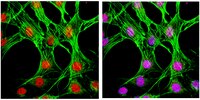MABS64 Sigma-AldrichAnti-phospho-p38 (Thr180/Tyr182) Antibody, clone 6E5.2
Detect phospho-p38 (Thr180/Tyr182) using this Anti-phospho-p38 (Thr180/Tyr182) Antibody, clone 6E5.2 validated for use in WB & IC.
More>> Detect phospho-p38 (Thr180/Tyr182) using this Anti-phospho-p38 (Thr180/Tyr182) Antibody, clone 6E5.2 validated for use in WB & IC. Less<<Recommended Products
Overview
| Replacement Information |
|---|
Key Spec Table
| Species Reactivity | Key Applications | Host | Format | Antibody Type |
|---|---|---|---|---|
| H, M | WB, ICC | M | Purified | Monoclonal Antibody |
| References |
|---|
| Product Information | |
|---|---|
| Format | Purified |
| Control |
|
| Presentation | Purified mouse monoclonal IgGκ in buffer containing 0.1 M Tris-Glycine (pH 7.4, 150 mM NaCl) with 0.05% sodium azide. |
| Quality Level | MQ100 |
| Physicochemical Information |
|---|
| Dimensions |
|---|
| Materials Information |
|---|
| Toxicological Information |
|---|
| Safety Information according to GHS |
|---|
| Safety Information |
|---|
| Storage and Shipping Information | |
|---|---|
| Storage Conditions | Stable for 1 year at 2-8°C from date of receipt. |
| Packaging Information | |
|---|---|
| Material Size | 100 µg |
| Transport Information |
|---|
| Supplemental Information |
|---|
| Specifications |
|---|
| Global Trade Item Number | |
|---|---|
| Catalogue Number | GTIN |
| MABS64 | 04053252478741 |
Documentation
Anti-phospho-p38 (Thr180/Tyr182) Antibody, clone 6E5.2 SDS
| Title |
|---|
Anti-phospho-p38 (Thr180/Tyr182) Antibody, clone 6E5.2 Certificates of Analysis
Brochure
| Title |
|---|
| Product Selection Guide - Antibodies, small molecule inhibitors, kits, assays and proteins for signaling research. |








